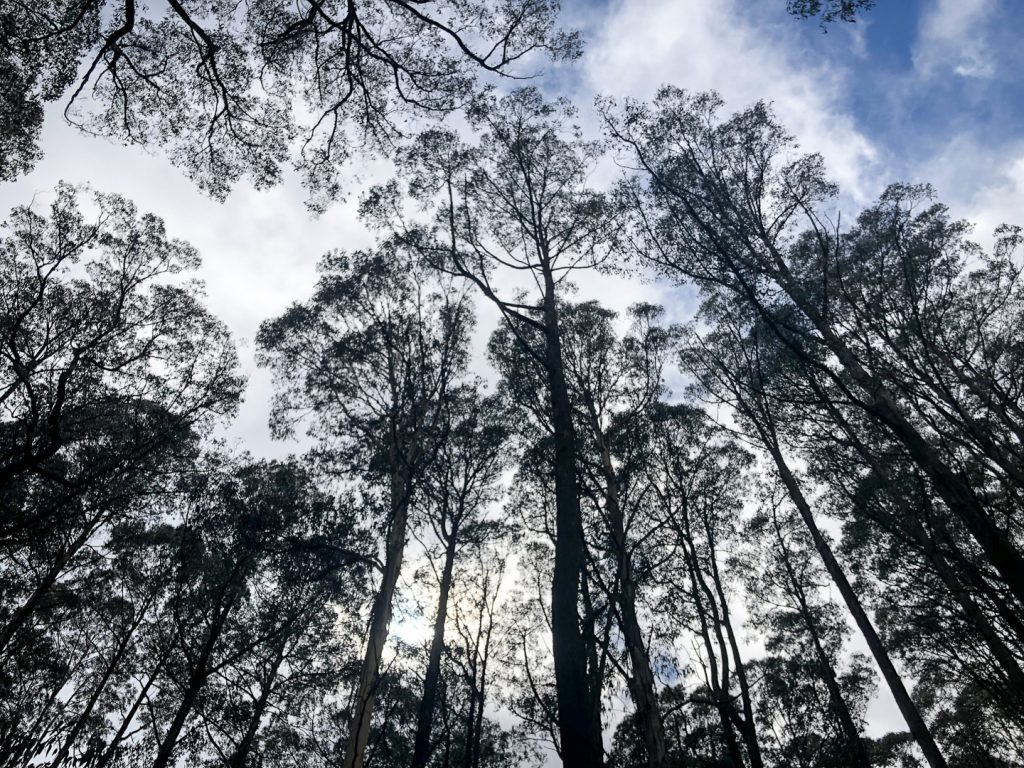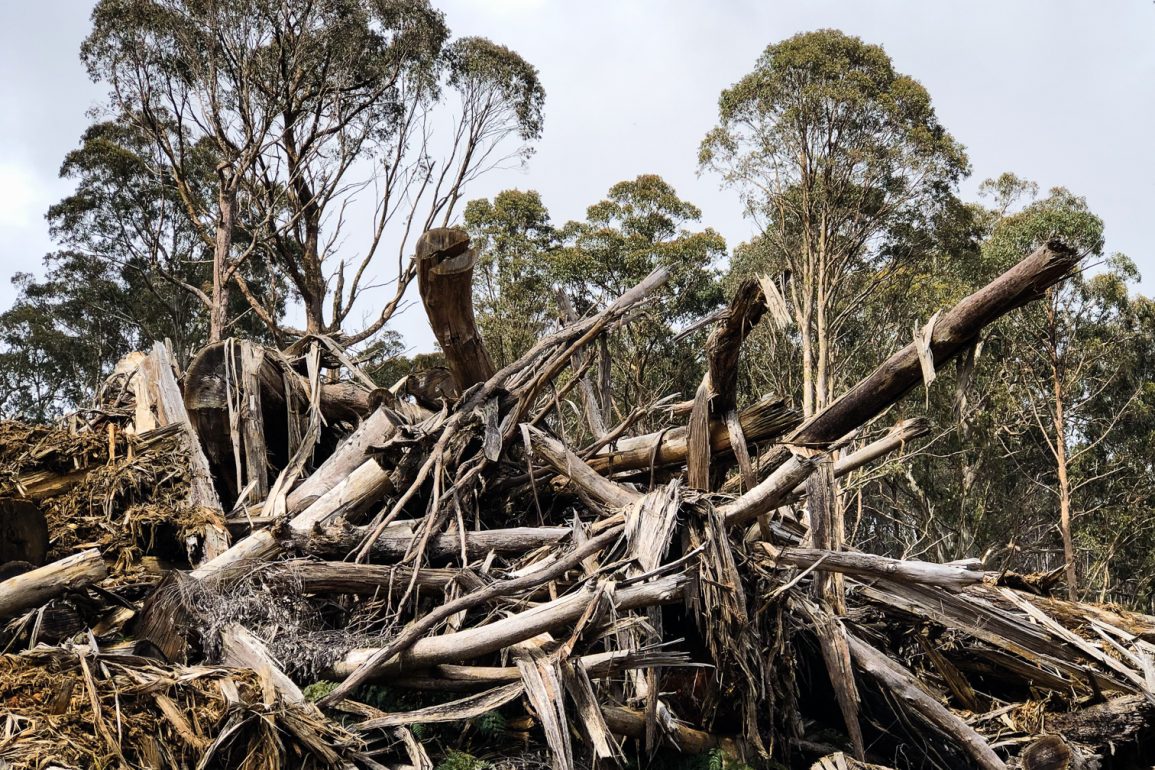We are living through a climate, environmental and biodiversity crisis. Yet logging of Victoria’s native forests continues unabated with devastating results for the ecology of forests. There is evidence that the Mountain Ash forests of the Central Highlands are on the verge of collapse through a combination of destruction through logging and climate change. An example of near forest collapse is the Toolangi State Forest, less than an hour out of Melbourne, and part of the Central Highlands. This example is being repeated in many other forested areas of the state, specifically in Gippsland and the Northeast.
The severe 1939 fires in Victoria affected a large proportion of the state and much of Toolangi State Forest was burnt. Much of the forest in Toolangi was able to regenerate naturally and logging started in the late 1970’s. Toolangi State Forest and forests in the north and eastern parts of the state have been logged since then by the Victorian government’s logging agency, VicForests, with logging coupes being opened up under so-called “timber release plans”.
When a coupe is logged, only 40 per cent of the forest matter, i.e. the logs, is taken out of the forest. The rest, 60 percent, which is referred to as “slash”, is burnt. It is difficult to regenerate a forest that has been destroyed; 50 percent of logged mountain ash fails to grow back after logging. If the forest does regenerate, the trees are left to grow for 40 years, and then the area is slated for re-logging. [1]

It takes a forest at least 80 years to become a mature forest and for biodiversity to recover. So the forests are being logged before they reach maturity. When a forest is logged extensively, overall it becomes a “young forest” and the richness of biodiversity, both flora and fauna, is threatened and often lost. Where once mature trees stood, they can be replaced by wattle and scrub. Thus, there is degradation of the forest, its habitat, and loss of biodiversity.
With heavy logging having been undertaken for the last 50 years throughout Victoria, the result is a patchwork of young to very young forest over a wide area, with areas that have regenerated, interspersed with those that have failed to regenerate. This area is sufficiently large, and the biodiversity so substantially destroyed, so as to threaten the viability of Mountain Ash forests in Victoria. [2]
The greater glider was once common in our forests. It lives in trees of about 130 years old and more, where hollows have formed from boughs that have dropped. Greater gliders cannot live in young trees because hollows have not yet formed. However, with the relentless destruction of its habitat, it was declared vulnerable in 2016 and has recently been declared endangered by Minister Tanya Plibersek. The Leadbeater’s Possum (Victoria’s faunal emblem) is also endangered because of the loss of hollows in mature trees.
The state government has pledged to end logging by 2030 but that date is too far into the future to prevent the major forest destruction and biodiversity loss that will occur.
Forests are also under threat from the increasing severity and frequency of fires fuelled by climate change. Professor David Lindenmayer, world renowned forest management and conservation ecologist, has made a study of the forests of Victoria’s Central Highlands and impacts from fire. He has found that there is a compelling relationship between fire severity and the age of a forest. The older a forest is, the more it is able to withstand the impacts of severe fire, and that the more a forest is logged, the more susceptible it becomes to being burnt.
VicForests has been operating at a loss. The government has funded major shortfalls of the agency, which have amounted to around $20 million annually for the past two years with the greatest loss being over $50 million this last financial year. [3]
So there is no economic argument for continuing to log native forests. Plantation timber accounts for 90 percent of requirements for the timber industry as a whole, and the market for timber for housing framework is now supplied exclusively by softwood plantation timber. [4]
So there is a strong argument for moving completely to plantation timber to supply the needs for the industry.
Our native forests are turned into nothing but wood chips. For our precious forests, with their majestic Mountain Ash eucalypts and their richly diverse ecosystems to end up as cheap paper and cardboard products, is a travesty.
In developments only this week, the white paper production line at the Maryvale paper mill has been shut down. The Maryvale Paper Mill has four other lines that use wood as raw materials. These include the packaging and cardboard lines. The Victorian government has a contract to supply Opal (a Japanese owned packaging company) with a set amount of wood from native forest. [5]
However the Supreme Court has ruled that VicForests must conduct full surveys of its logging coupes to check for two endangered species of gliders and protect their immediate habitat. As a consequence, the forests have had a reprieve from logging since last November. [6]
Urgent action to save our forests needs to happen now. If you feel passionate, and appalled that only 1.1 percent of our old growth Mountain Ash forest remains, please write to Ingrid Stitt MLC, our new Victorian environment minister.
References:
- https://environmentvictoria.org.au/wp-content/uploads/2021/07/AfterTheLogging_Nov21-1.pdf
- This article in The Age reports on Professor Lindenmayer’s work on forest collapse and his 2018 report.
This report discusses fragmentation of forests and its effect. - https://www.theage.com.au/environment/conservation/logging-agency-vicforests-blames-legal-woes-for-record-financial-loss-20221221-p5c7yl.html
- https://djsir.vic.gov.au/forestry/managing-our-forests/plantations#:~:text=Plantations%20are%20purpose%20grown%20for,different%20times%20in%20their%20lifecycle.
- https://www.legislation.vic.gov.au/in-force/acts/forests-wood-pulp-agreement-act-1996/001
- Here is an article from The Guardian, reporting on the closure of the white paper line https://www.theguardian.com/australia-news/2023/feb/16/australias-white-paper-industry-is-dead-leaving-rural-communities-to-pick-through-the-pulp






